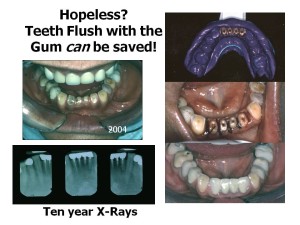Many patients are having teeth extracted even when they can actually be saved. These teeth are being extracted because there is no tooth structure above the gum, there is poor periodontal bone, or poor root anatomy that cannot support fixed bridgework. In fact, only teeth with fractures below the periodontal bone and teeth with little or no periodontal bone cannot be saved.
Many patents are surprised to learn that teeth that have no tooth structure above the gum are far from hopeless! Tooth structure above the gum is actually meaningless–it is the tooth structure below the gum that should determine whether teeth can be saved. Most dentists have been trained to focus only on tooth structure above the gum in order to save teeth. If they do not have enough tooth structure above the gum to retain a restoration, they try to build up the tooth with various materials or with pins and posts. Some try to orthodontically erupt the teeth to move tooth structure above the gum. Today, the trend is to extract these teeth and place implants.
However, there is a precision technique for restoring teeth that only requires tooth structure below the gum for restoration. This technique came from the roots of modern dentistry, but is no longer taught in dental schools. No build-ups or potentially destructive posts are required, and the restorations can be worn with Vaseline® without falling out. It is far better to save one’s own tooth if the root is sound than to place an implant.
Every Doctor has heard Hippocrates famous saying , “first, do no harm”. In my view this means, “teeth can always be extracted,” so implant placement should be a last resort rather than a first resort when it comes to dealing with “hopeless” teeth. In truth, no one can predict how long even the most “hopeless” of teeth can last. There have been many instances where teeth condemned as “hopeless” by dental practitioners have lasted in health for many years after corrective treatment—often in spite of diabetes, cancer and heart disease! It never fails to amaze me how long these teeth actually last when all the deformities are corrected. Miracles can happen!
Teeth that are truly “hopeless” can be quite useful, as they can facilitate gradual transitions to different types of restorations. Gradual transitions are much kinder to patients than drastic changes. Most patients, for example, have a great deal of difficulty adjusting physically and psychologically to an “immediate” denture—i.e. a denture that is placed in the mouth the day all the teeth are extracted. I never saw one patient yet who did well with this procedure. Saving those “hopeless” teeth can provide great comfort and peace of mind to patients by easing such a transition.
MAY
2015

About the Author:
Since graduating from Tufts University in 1977, Dr. Edward Feinberg has been on a mission to help patients and improve the profession of Dentistry. A practicing dentist in Scarsdale, New York, he is the successor to a tradition established in 1948 by his father, Dr. Elliot Feinberg--a renowned expert, teacher and author in the field of crown and bridgework, precision attachment partial dentures and implant restorations. The principles and techniques of this tradition are documented in a growing collection of more than 100,000 slides of cases that date back to 1950.